
|
CYAO: Cyanobacterial Platform Optimised for Bioproduction
|
|
|
|
|
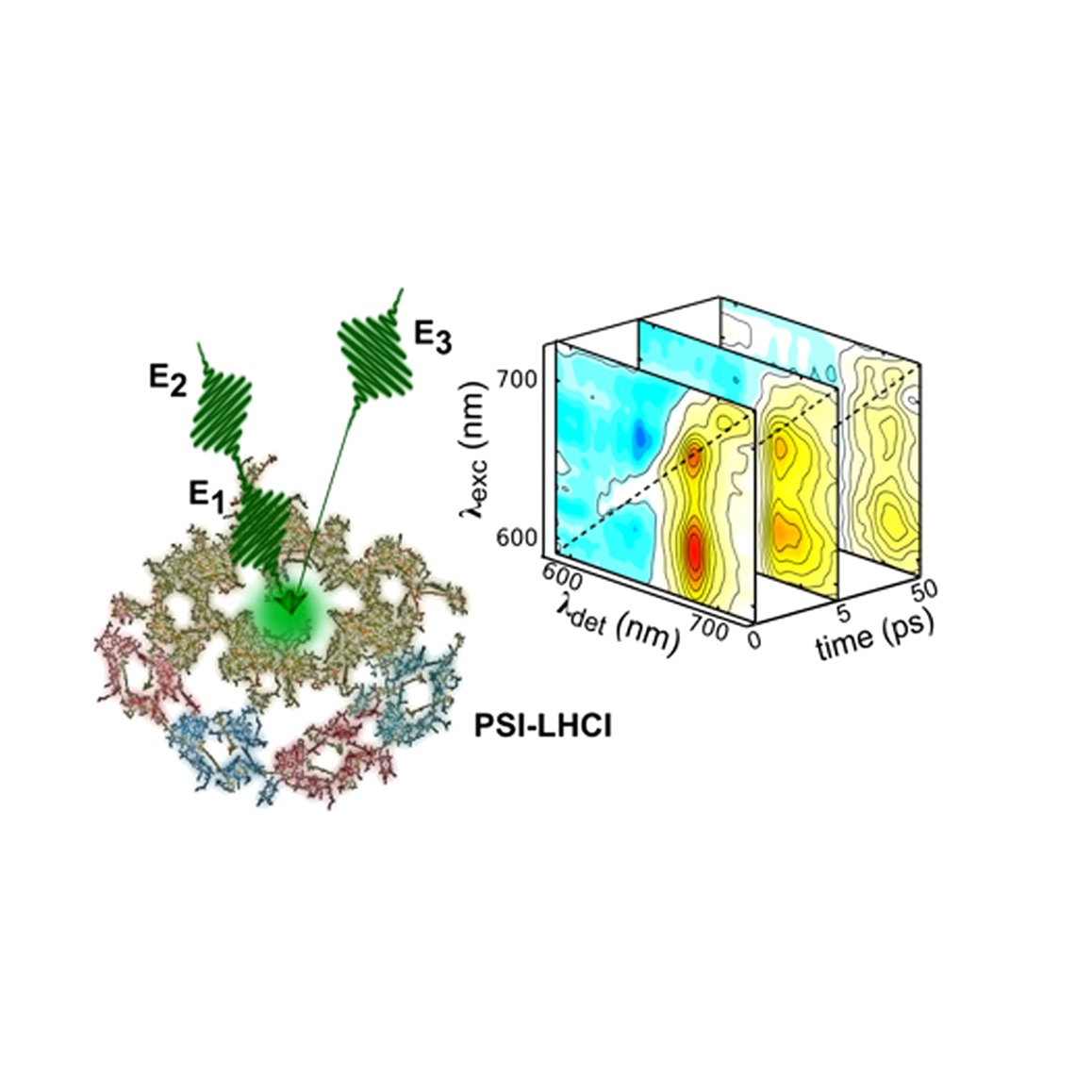 |
Direct Evidence for Excitation Energy Transfer Limitations Imposed by Low-Energy Chlorophylls in Photosystem I-Light Harvesting Complex I of Land Plants
Russo M, Casazza AP, Cerullo G,Santabarbara S, Maiuri M
J. Phys. Chem. B (2021) 125(14):3566-3573. doi:10.1021/acs.jpcb.1c01498 Free PMC article
Abstract
The overall efficiency of photosynthetic energy conversion depends both on photochemical and excitation energy transfer processes from extended light-harvesting antenna networks. Understanding the
trade-offs between increase in the antenna cross section and bandwidth and photochemical conversion efficiency is of central importance both from a biological perspective and for the design of biomimetic
artificial photosynthetic complexes. Here, we employ two-dimensional electronic spectroscopy to spectrally resolve the excitation energy transfer dynamics and directly correlate them with the initial
site of excitation in Photosystem I-Light Harvesting Complex I (PSI-LHCI) supercomplex of land plants, which has both a large antenna dimension and a wide optical bandwidth extending to energies lower than
the peak of the reaction center chlorophylls. Upon preferential excitation of the low-energy chlorophylls (red forms), the average relaxation time in the bulk supercomplex increases by a factor of
2-3 with respect to unselective excitation at higher photon energies. This slowdown is interpreted in terms of an excitation energy transfer limitation from low-energy chlorophyll forms in the PSI-LHCI.
These results aid in defining the optimum balance between the extension of the antenna bandwidth to the near-infrared region, which increases light-harvesting capacity, and high photoconversion
quantum efficiency.
| |
|
|
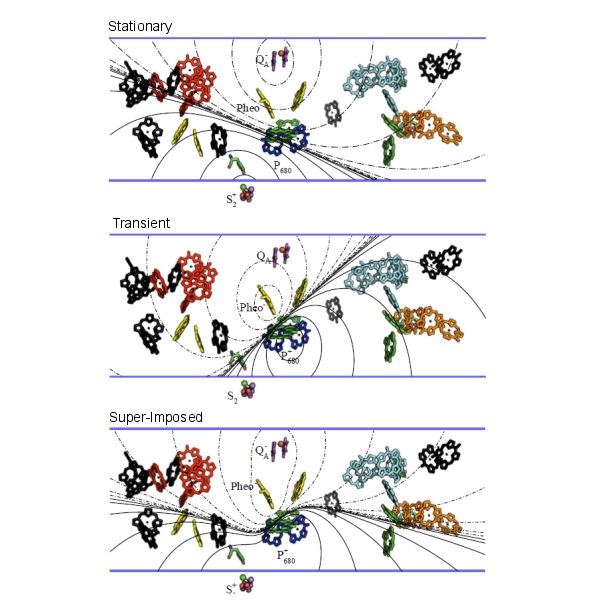 |
Direct Evidence for Excitation Energy Transfer Limitations Imposed by Low-Energy Chlorophylls in Photosystem I-Light Harvesting Complex I of Land Plants
Sipka GB, Magyar M, Mezzetti A, Akhtar P, Zhu Q, Xiao Y, Han G, Santabarbara S, Shen JR, Lambrev PH, Garab G
Plant Cell (2021) 33(4):1286-1302. doi:10.1093/plcell/koab008 Open Access
Abstract
Photosystem II (PSII) uses solar energy to oxidize water and delivers electrons for life on Earth. The photochemical reaction center of PSII is known to possess two stationary states. In the open state (PSIIO),
the absorption of a single photon triggers electron-transfer steps, which convert PSII into the charge-separated closed state (PSIIC). Here, by using steady-state and time-resolved spectroscopic techniques on
Spinacia oleracea and Thermosynechococcus vulcanus preparations, we show that additional illumination gradually transforms PSIIC into a light-adapted charge-separated state (PSIIL). The PSIIC-to-PSIIL transition,
observed at all temperatures between 80 and 308 K, is responsible for a large part of the variable chlorophyll-a fluorescence (Fv) and is associated with subtle, dark-reversible reorganizations in the core complexes,
protein conformational changes at noncryogenic temperatures, and marked variations in the rates of photochemical and photophysical reactions. The build-up of PSIIL requires a series of light-induced events generating
rapidly recombining primary radical pairs, spaced by sufficient waiting times between these events-pointing to the roles of local electric-field transients and dielectric relaxation processes.
We show that the maximum fluorescence level, Fm, is associated with PSIIL rather than with PSIIC, and thus the Fv/Fm parameter cannot be equated with the quantum efficiency of PSII photochemistry. Our findings
resolve the controversies and explain the peculiar features of chlorophyll-a fluorescence kinetics, a tool to monitor the functional activity and the structural-functional plasticity of PSII in different wild-types
and mutant organisms and under stress conditions.
| |
|
|
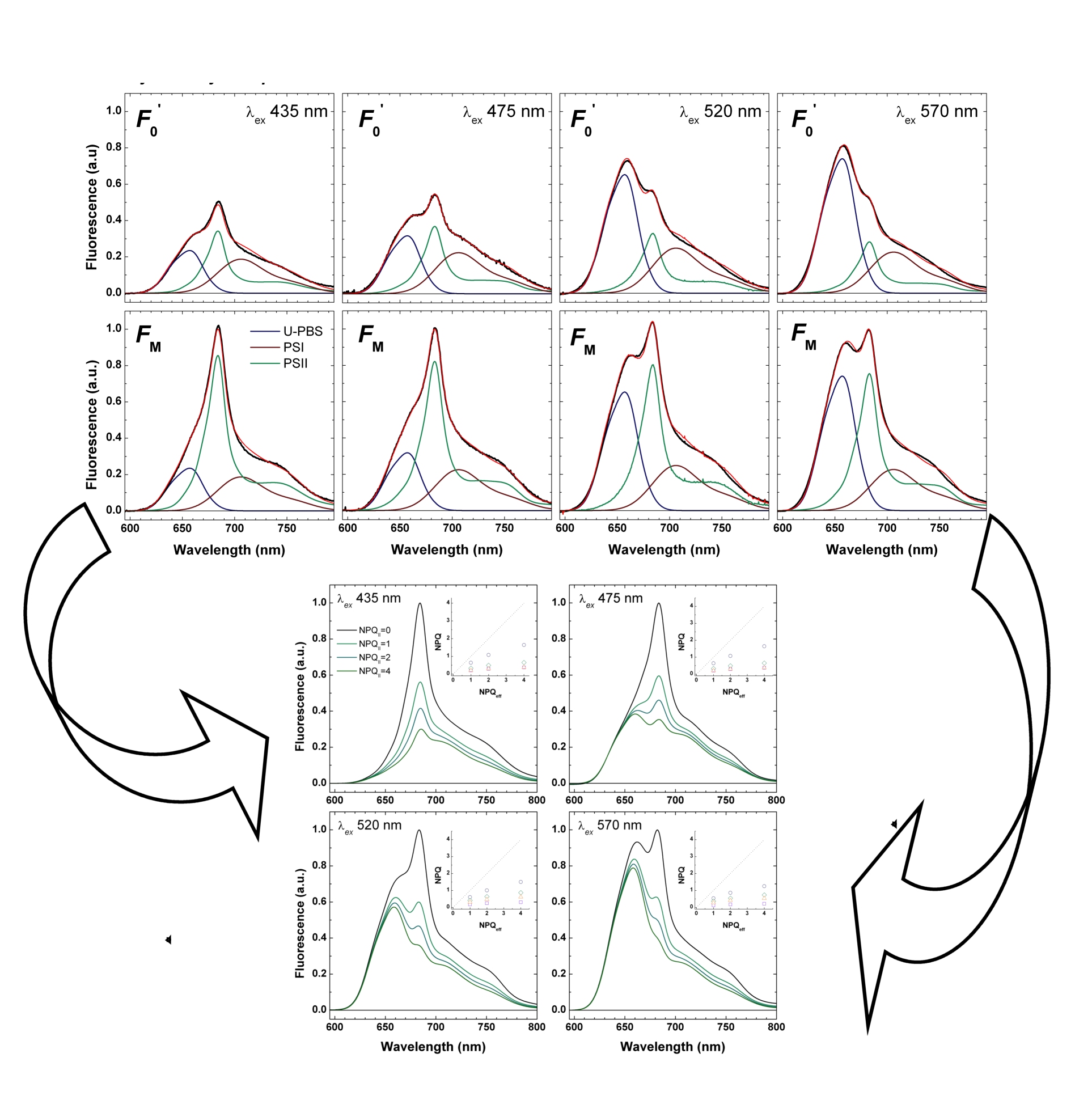 |
Influence of the Wavelength of Excitation and Fluorescence Emission Detection on the Estimation of Fluorescence-Based Physiological Parameters in Different Classes of Photosynthetic Organisms
Santabarbara S, Petrova AA, Remelli W, Casazza AP
in Fluorescence Methods for Investigation of Living Cells and Microorganisms (Grigorieva N. Ed), Intech Open (2020) PP. 221-233. doi:10.5772/intechopen.93230.
Open Access
Abstract
Fluorescence-based methodologies are commonly employed to determine a wide spectrum of physiological parameters in intact photosynthetic organisms.
These methods rely on the detection of Chlorophyll a fluorescent emission, which exhibits changes in its intensity due to the occurrence of quenching
phenomena of either photochemical or non-photochemical nature, as well as in response of the absorption cross-section of the photosystems.
At room temperature, it is generally considered that most of the emission stems from Photosystem II, and therefore, most of the physiological
parameters rely on the assumption that contribution from Photosystem I is negligible. Moreover, it is often considered that the whole light-harvesting
antenna is efficiently coupled to either of the photosystems and does not contribute, independently, to the detected emission. When these caveats are
not realised, fluorescence-based indicators might be subjected to biases that tend to underestimate the extent of both photochemical and
non-photochemical quenching. The contribution of Photosystem I and partially coupled/antenna components can be assessed through the analysis
of the dependency of steady-state emission as a function of both the excitation and the emission wavelengths. On this basis, methods relying on
using different combinations of excitation and emission wavelengths will be discussed in order to minimise the bias on the estimation of
physiologically relevant parameters.
| |
|
|
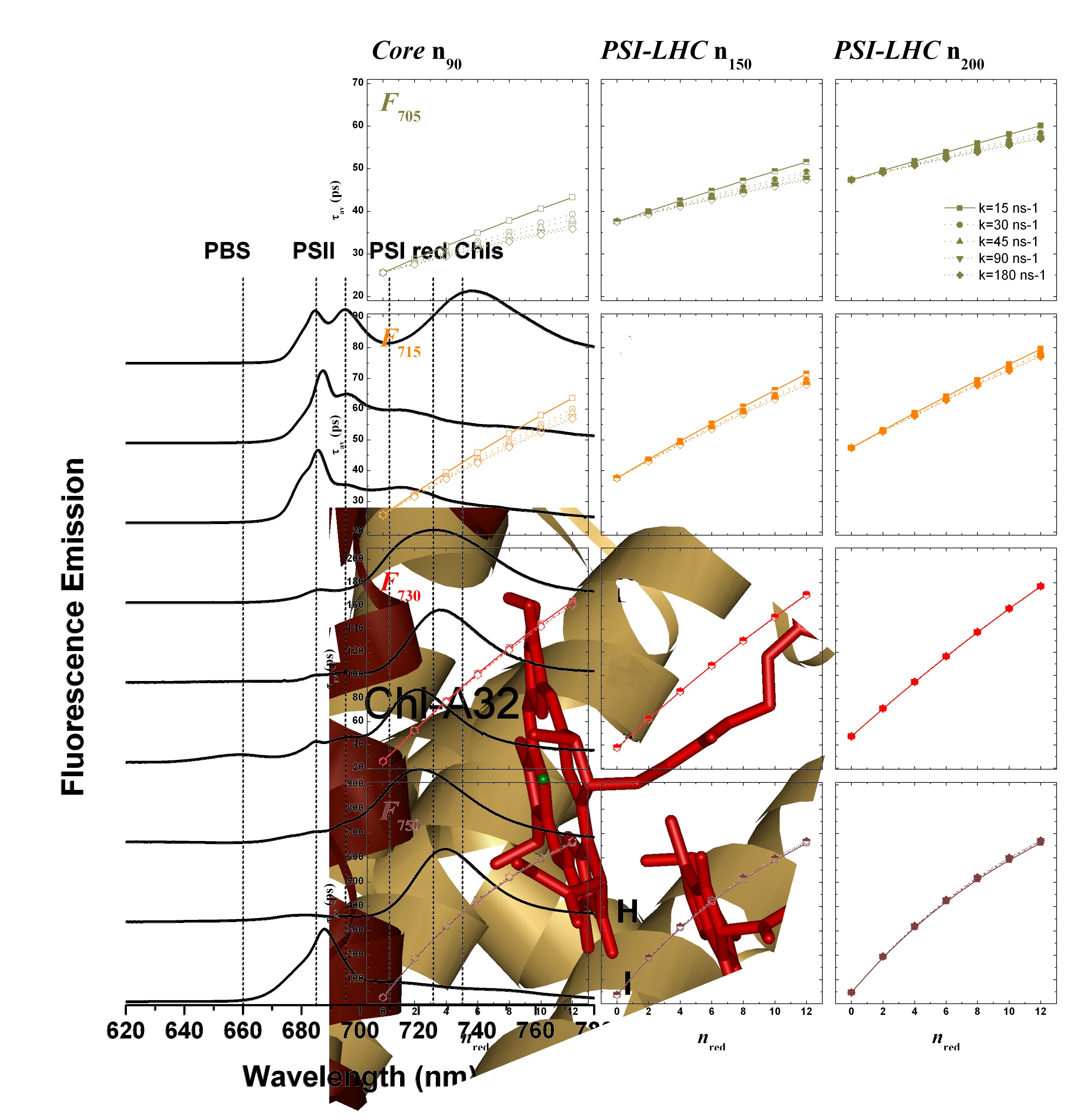 |
Light Harvesting by Long-Wavelength Chlorophyll Forms (Red Forms) in Algae: Focus on their Presence, Distribution and Function
Santabarbara S, Casazza AP, Belgio E, Kana E, Prßsil O
in Photosynthesis in Algae: Biochemical and Physiological Mechanisms. (Larkum A, Grossman A, Raven J Eds)
Advances in Photosynthesis and Respiration (Including Bioenergy and Related Processes), vol 45. Springer,
(2020) PP. 261-297. doi:10.1007/978-3-030-33397-3_11.
Abstract
The efficiency by which oxygenic photosynthetic organisms, and particularly microalgae, utilise near infrared radiation for sustaining metabolic processes has attracted attention since the pioneering studies of Emerson and coworkers. In the vast majority of photosynthetic organisms,
which use Chlorophyll (Chl) a as their main light harvesting as well as photochemically active pigment, the capacity of absorbing incident photons
at wavelengths longer than 700 nm is associated with the presence of specific Chl a spectral forms, known as ôred formsö. These have been considered
to be almost exclusively, and rather ubiquitously, associated to either the core or the external light harvesting apparatus of Photosystem I (PSI).
Therefore a large body of information has been gathered, concerning red forms associated with either the core antenna of cyanobacteria or the
external light harvesting complexes of green algae as well as those of higher plants which share a common structural architecture. On the other
hand, recent ecophysiological in field measurements, together with studies performed in the laboratory on model red clade organisms, challenged
this general consensus. In field measurements put in evidence that the presence of PSI red forms, particularly in oceanic waters, is probably less
diffused than generally assumed on the basis of model organisms analysis. Moreover, the study of red clade algae demonstrated the presence of red
spectral forms associated also to Photosystem II (PSII), particularly under conditions of culture self-shading or growth under far-red illumination.
Therefore, in this review chapter the nature and photophysical/photophysiological role of red forms associated to both PSI and PSII will be
surveyed and discussed. Moreover a general discussion of the impact of antenna forms absorbing at lower energies than the respective reaction
centres, therefore being in competition for excited state localisation with photochemical processes and productive photon energy utilisation,
will be discussed in a simplified, although generalised, framework.
| |
|
|
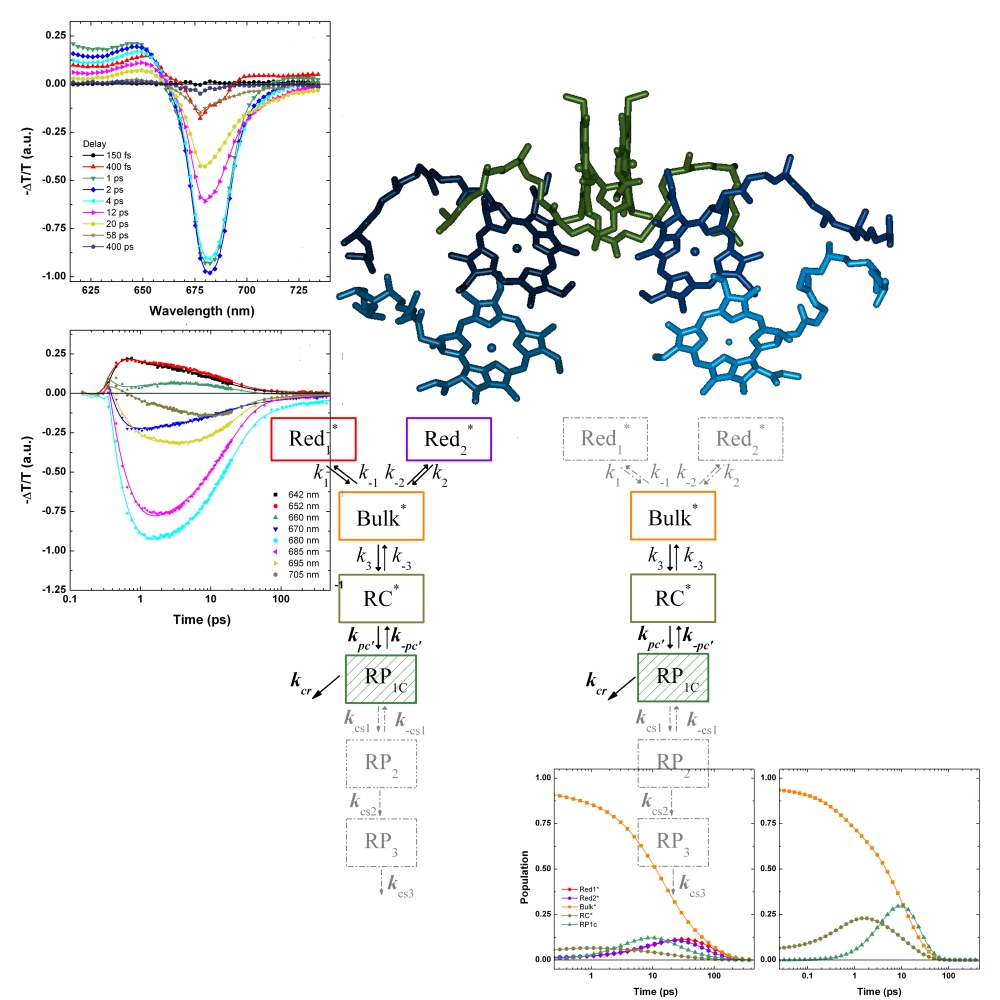 |
Ultrafast excited-state dynamics in land plants Photosystem I core and whole supercomplex under oxidised electron donor conditions
Russo M, Petropoulos V, Molotokaite E, Cerullo G, Casazza AP, Maiuri M, Santabarbara S
Photosynth. Res. (2020) 144(2):221-233. doi: 10.1007/s11120-020-00717-y.
Abstract
The kinetics of excited-state energy migration were investigated by femtosecond transient absorption in the isolated Photosystem I-Light-Harvesting Complex I (PSI-LHCI) supercomplex
and in the isolated PSI core complex of spinach under conditions in which the terminal electron donor P700 is chemically pre-oxidised. It is shown that, under these conditions, the relaxation of
the excited state is characterised by lifetimes of about 0.4 ps, 4.5 ps, 15 ps, 35 ps and 65 ps in PSI-LHCI and 0.15 ps, 0.3 ps, 6 ps and 16 ps in the PSI core complex. Compartmental spectral-kinetic modelling
indicates that the most likely mechanism to explain the absence of long-lived (ns) excited states is the photochemical population of a radical pair state, which cannot be further stabilised and decays non-radiatively
to the ground state with time constants in the order of 6-8 ps.
| |
|
|
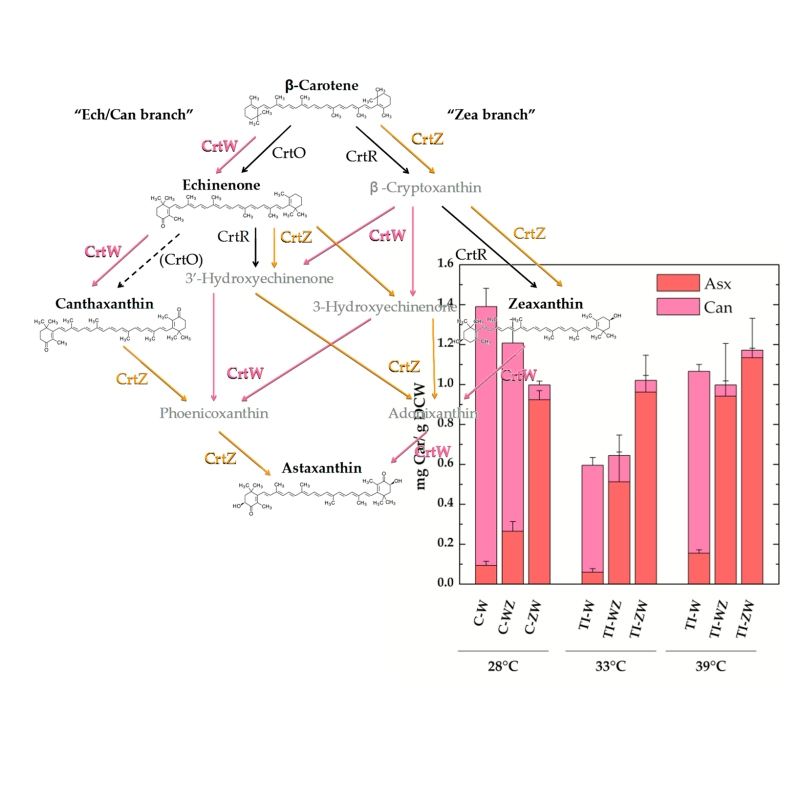 |
A Comparison of Constitutive and Inducible Non-Endogenous Keto-Carotenoids Biosynthesis in Synechocystis sp. PCC 6803
Menin B, Lami A, Musazzi S, Petrova AA, Santabarbara S, Casazza AP
Microorganisms (2019) 7(11). pii:E501. doi: 10.3390/microorganisms7110501. Open Access.
Abstract
The model cyanobacterium Synechocystis sp. PCC 6803 has gained significant attention as an alternative and sustainable source for biomass,
biofuels and added-value compounds. The latter category includes keto-carotenoids, which are molecules largely employed in a wide spectrum of industrial
applications in the food, feed, nutraceutical, cosmetic and pharmaceutical sectors. Keto-carotenoids are not naturally synthesized by Synechocystis, at
least in any significant amounts, but their accumulation can be induced by metabolic engineering of the endogenous carotenoid biosynthetic pathway.
In this study, the accumulation of the keto-carotenoids astaxanthin and canthaxanthin, resulting from the constitutive or temperature-inducible expression of
the CrtW and CrtZ genes from Brevundimonas, is compared. The benefits and drawbacks of the two engineering approaches are
discussed.
| |
|
|
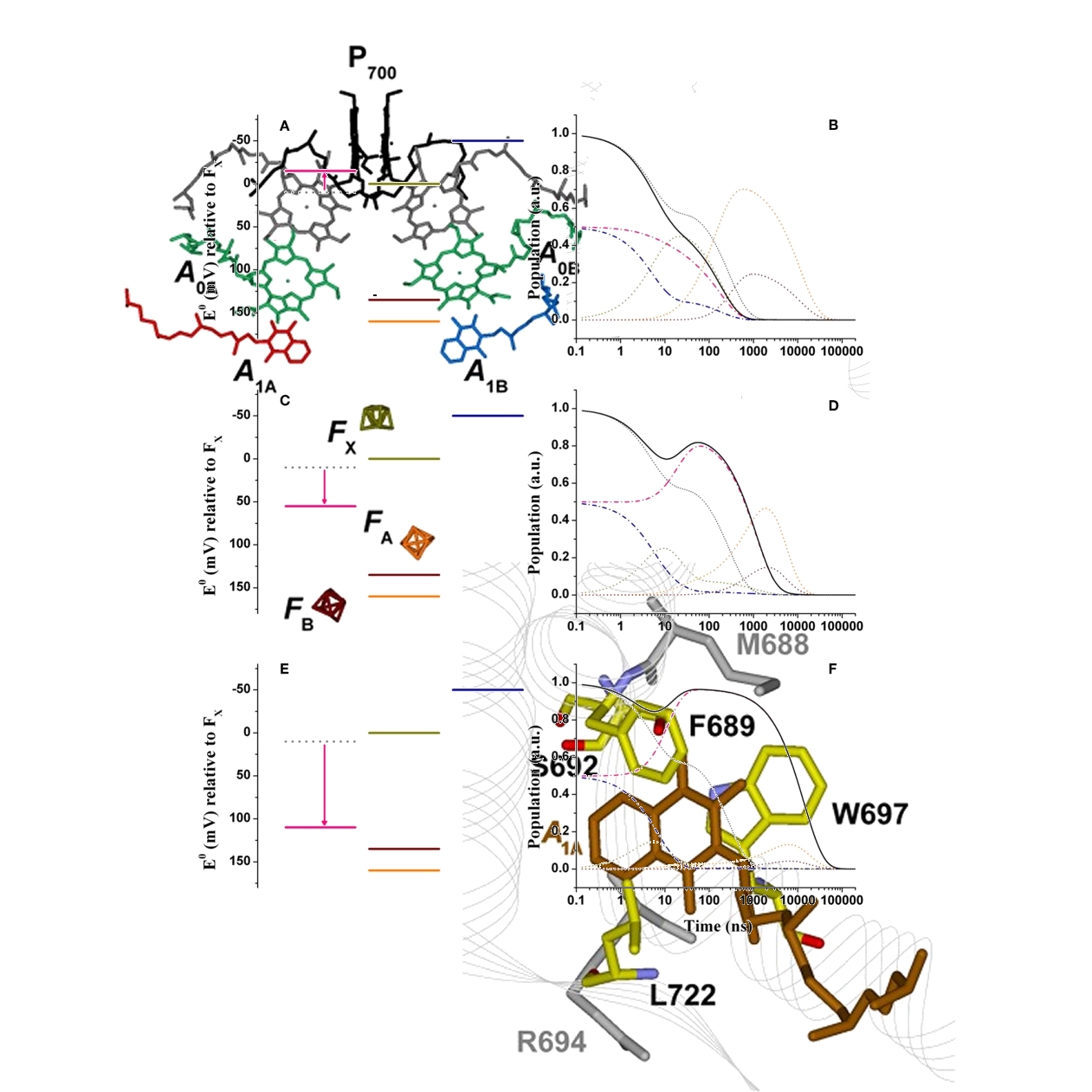 |
Kinetics and Energetics of Phylloquinone Reduction in Photosystem I: Insight From Modeling of the Site Directed Mutants
Santabarbara S, Casazza AP
Front. Plant. Sci. (2019) 2;10:852. doi: 10.3389/fpls.2019.00852. eCollection 2019. Open Access.
Abstract
Two phylloquinone molecules (A1), one being predominantly coordinated by PsaA subunit residues (A1A) the other by those of
PsaB (A1B), act as intermediates in the two parallel electron transfer chains of Photosystem I. The oxidation kinetics of the two
phyllosemiquinones by the iron-sulfur cluster FX differ by approximately one order of magnitude, with (A1A-) being
oxidized in about 200 ns and A1B- in about 20 ns. These differences are generally explained in terms of asymmetries in the
driving force for FX reduction on the two electron transfer chains. Site directed mutations of conserved amino acids composing the A1
binding site have been engineered on both reaction center subunits, and proved to affect selectively the oxidation lifetime of either
(A1A), for PsaA mutants, or (A1B), for PsaB mutants. The mutation effects are here critically reviewed, also by novel
modeling simulations employing the tunneling formalism to estimate the electron transfer rates. Three main classes of mutation effects are in
particular addressed: (i) those leading to an acceleration, (ii) those leading to a moderated slowing (~5-folds), and (iii) those leading to a
severe slowing (>20-folds) of the kinetics. The effect of specific amino acid perturbations contributing to the poising of the phylloquinones redox
potential and, in turn, to PSI functionality, is discussed.
| |
|
|
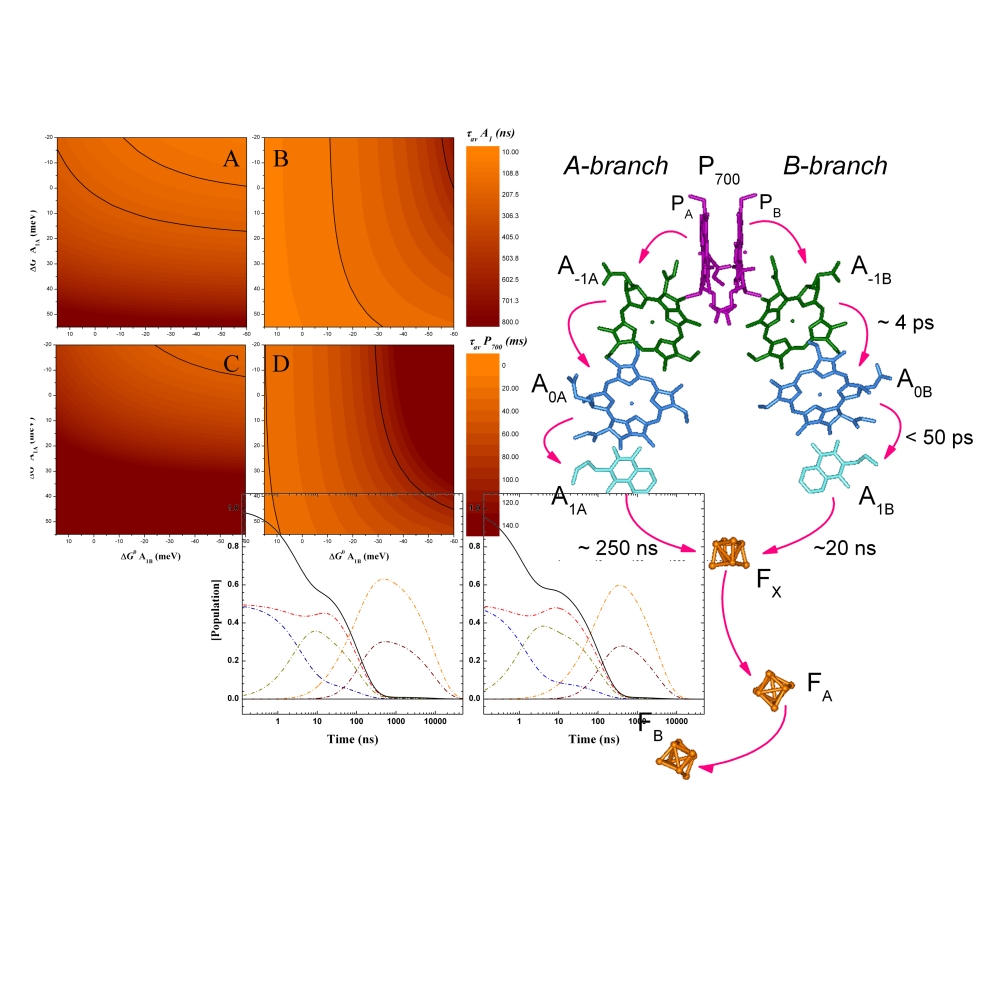 |
Modelling electron transfer in photosystem I: Limits and perspectives
Santabarbara S, Casazza AP, Hastings G.
Physiol. Plant. (2019) 166:73-87. doi: 10.1111/ppl.12959.
Abstract
Uncovering the parameters underlying the electron transfer (ET) in photosynthetic reaction centres is of importance for understanding the molecular mechanisms underpinning their functionality.
The reductive nature of most cofactors involved in photosynthetic ET makes the direct estimation of their properties difficult. Photosystem I (PSI) operate in a highly reducing regime, making
the assessment of cofactor properties even more difficult. Kinetic modelling coupled to a non-adiabatic description of ET is a useful approach in overcoming this hindrance. Here we review the
theory and modelling approaches that have been used in assessing parameters associated with ET reactions in PSI, with particular attention to ET reactions involving the phylloquinones (PhQ)
and the iron-sulphur clusters. In most modelling studies the goal is to estimate the driving force of ET, which usually is associated with the cofactor midpoint potentials. The driving force
is sensitive to many factors, which define the ET rate, i.e. the reorganisation energy, the coupling with nuclear modes and the electronic matrix elements, which are explored and discussed here.
The importance of an inclusive modelling of both forward and reverse ET processes is discussed and highlighted. It is shown that, although estimates are indeed sensitive to the exact parameter sets employed
in the modelling, a general consensus is still attained, pointing to a scenario where Delta(G0A1A/FX)/Delta(G0A1B/FX) is weakly endergonic/exergonic, respectively. It is emphasised that to further refine those estimates,
it will require a joint effort between computational modelling and more wide-ranging experimental studies.
| |
|
|
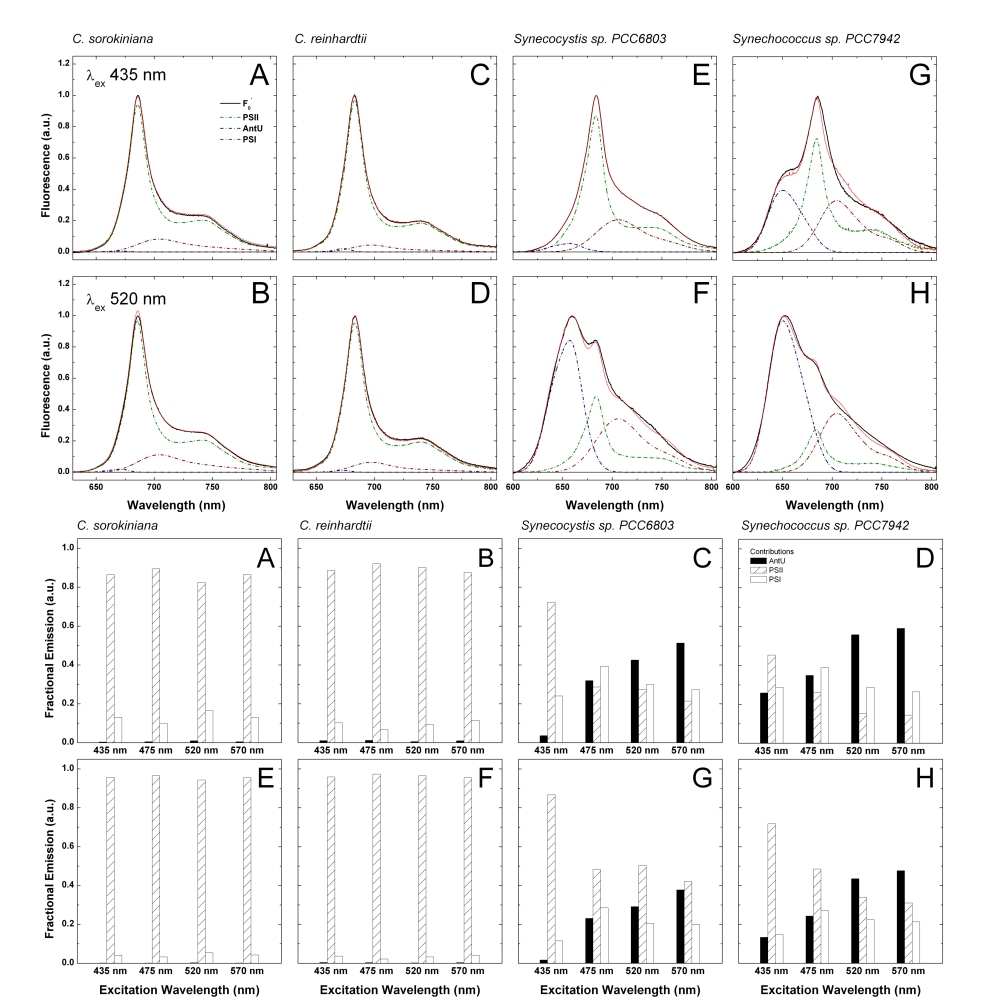 |
Comparative excitation-emission dependence of the FV/FM ratio in model green algae and cyanobacterial strains
Santabarbara S, Villafiorita Monteleone F, Remelli W, Rizzo F, Menin B, Casazza AP.
Physiol Plant. (2019) 166:351-364. doi: 10.1111/ppl.12931.
Abstract
The emission spectra collected under conditions of open (F0) and closed (FM) photosystem II (PSII) reaction centres are close-to-independent from the excitation wavelength in Chlamydomonas reinhardtii
and Chlorella sorokiniana, whereas a pronounced dependence is observed in Synechocystis sp. PCC6803 and Synechococcus sp. PCC7942, instead. The differences in band-shape between the F0 and FM
emission are limited in green algae, giving rise only to a minor trough in the FV/FMspectrum in the 705-720 nm range, irrespectively of the excitation. More substantial variations are observed in cyanobacteria, resulting in marked
dependencies of the measured FV/FM ratios on both the excitation and the detection wavelengths. In cyanobacteria, the maximal FV /FM values (0.5-0.7), observed monitoring at approximately 684 nm and exciting Chl a
preferentially, are comparable to those of green algae; however, FV /FM decreases sharply below approximately 660 nm. Furthermore, in the red emission tail, the trough in the FV /FM spectrum is more pronounced in
cyanobacteria with respect to green algae, corresponding to FV /FM values of 0.25-0.4 in this spectral region. Upon direct phycobilisomes excitation (i.e. >520 nm), the FV /FM value
detected at 684 nm decreases to 0.3-0.5 and is close-to-negligible (approximately 0.1) below 660 nm. At the same time, the FV spectra are, in all species investigated, almost independent on the excitation wavelength. It is concluded that
the excitation/emission dependencies of the FV /FM ratio arise from overlapped contributions from the three independent emissions of PSI, PSII and a fraction of energetically uncoupled external antenna, excited
in different proportions depending on the respective optical cross-section and fluorescence yield.
| |
|
|
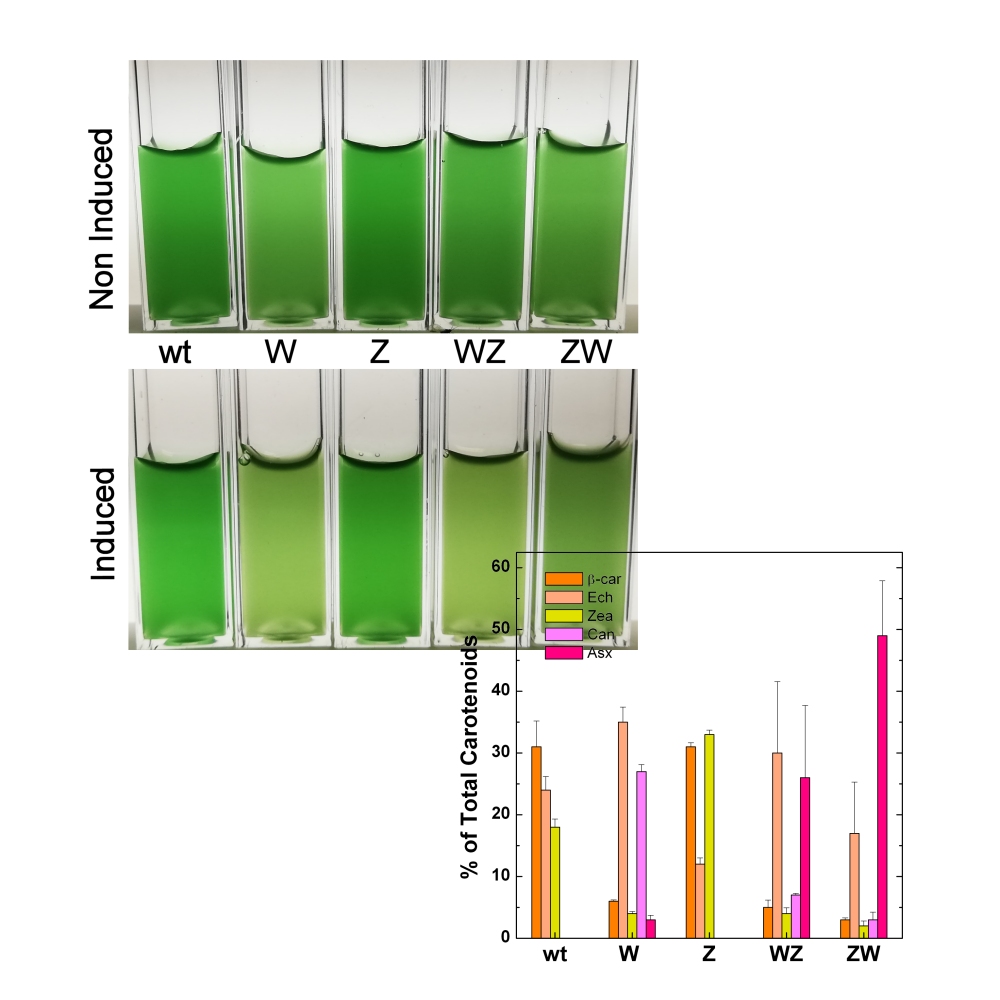 |
Non-endogenous ketocarotenoid accumulation in engineered Synechocystis sp. PCC 6803
Menin B, Santabarbara S, Lami A, Musazzi S, Villafiorita Monteleone F, Casazza AP.
Physiol. Plant. (2019) 166:403-412. doi: 10.1111/ppl.12900.
Abstract
The cyanobacterium Synechocystis sp. PCC 6803 is a model species commonly employed for biotechnological applications. It is naturally able to accumulate zeaxanthin (Zea) and echinenone (Ech), but not astaxanthin (Asx),
which is the highest value carotenoid produced by microalgae, with a wide range of applications in pharmaceutical, cosmetics, food and feed industries. With the aim of finding an alternative and sustainable biological
source for the production of Asx and other valuable hydroxylated and ketolated intermediates, the carotenoid biosynthetic pathway of Synechocystis sp. PCC 6803 has been engineered by introducing the
4,4' ▀-carotene oxygenase (CrtW) and 3,3' ▀-carotene hydroxylase (CrtZ) genes from Brevundimonas sp. SD-212 under the control of a temperature-inducible promoter. The expression of exogenous CrtZ led to an increased
accumulation of Zea at the expense of Ech, while the expression of exogenous CrtW promoted the production of non-endogenous canthaxanthin and an increase in the Ech content with a concomitant strong reduction of
▀-carotene (▀-car). When both Brevundimonas sp. SD-212 genes were coexpressed, significant amounts of non-endogenous Asx were obtained accompanied by a strong decrease in ▀-car content. Asx accumulation was higher
(approximately 50% of total carotenoids) when CrtZ was cloned upstream of CrtW, but still significant (approximately 30%) when the position of genes was inverted. Therefore, the engineered strains constitute a useful
tool for investigating the ketocarotenoid biosynthetic pathway in cyanobacteria and an excellent starting point for further optimisation and industrial exploitation of these organisms for the production of
added-value compounds.
| |
|
|
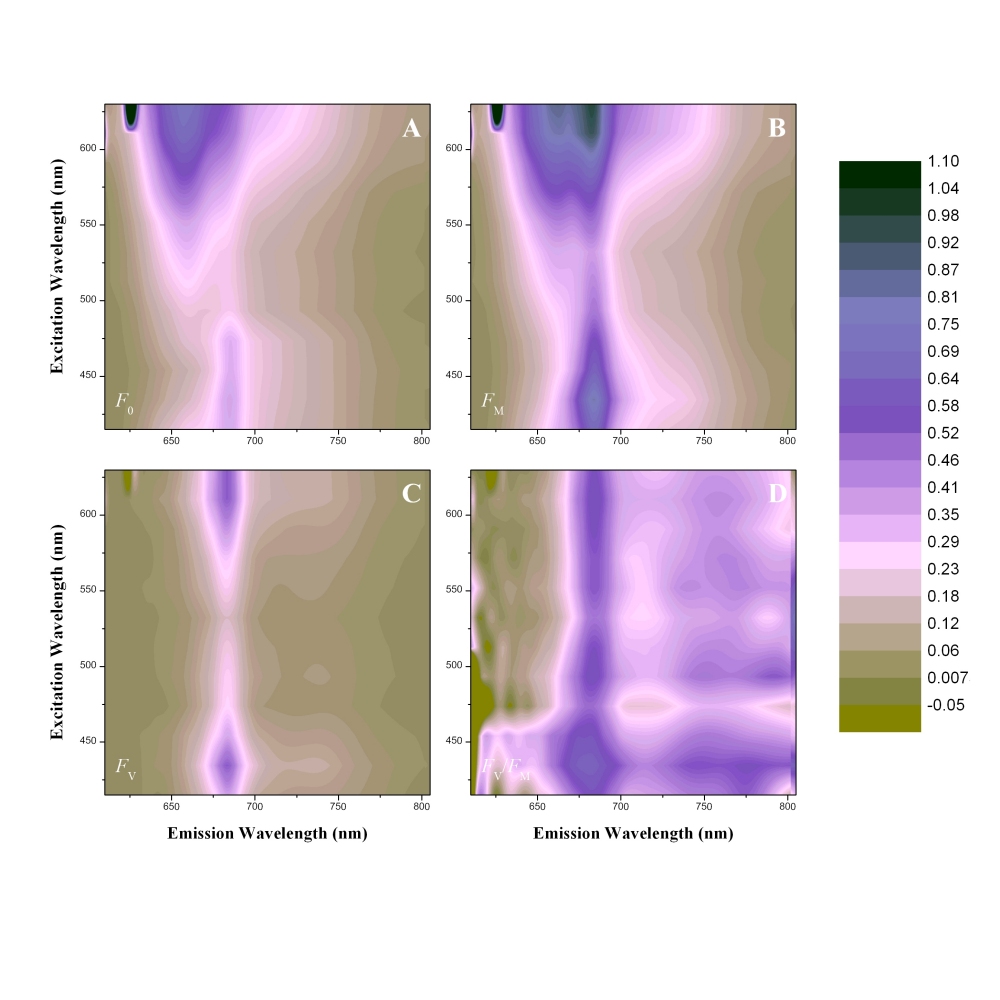 |
Excitation and emission wavelength dependence of fluorescence spectra in whole cells of the cyanobacterium Synechocystis sp. PPC6803: Influence on the estimation of Photosystem II maximal quantum efficiency
Remelli W, Santabarbara S.
Biochim. Biophys. Acta (2018) 1859:1207-1222.
Abstract
The fluorescence emission spectrum of Synechocystis sp. PPC6803 cells, at room temperature, displays: i) significant bandshape variations when collected under open (F0) and closed (FM) Photosystem II
reaction centre conditions; ii) a marked dependence on the excitation wavelength both under F0 and FM conditions, due to the enhancement of phycobilisomes (PBS) emission upon their direct excitation.
As a consequence: iii) the ratio of the variable and maximal fluorescence (FV/FM), that is a commonly employed indicator of the maximal photochemical quantum efficiency of PSII (Fpc, PSII), displays a
significant dependency on both the excitation and the emission (detection) wavelength; iv) the FV/FM excitation/emission wavelength dependency is due, primarily, to the overlap of PSII emission with that
of supercomplexes showing negligible changes in quantum yield upon trap closure, i.e. PSI and a PBS fraction which is incapable to transfer the excitation energy efficiently to core complexes.
v) The contribution to the cellular emission and the relative absorption-cross section of PSII, PSI and uncoupled PBS are extracted using a spectral decomposition strategy. It is concluded that
vi) Φpc,PSII is generally underestimated from the FV/FM measurements in this organism and, the degree of the estimation bias, which can exceed 50%, depends on the measurement conditions.
Spectral modelling based on the decomposed emission/cross-section profiles were extended to other processes typically monitored from steady-state fluorescence measurements, in the presence of
an actinic illumination, in particular non-photochemical quenching. It is suggested that vii) the quenching extent is generally underestimated in analogy to FV/FM but that viii) the location of
quenching sites can be discriminated based on the combined excitation/emission spectral analysis.
| |
|
|
The research is founded by the Cariplo Foundation under the Biotechnology founding scheme
|
 |
|
|
CYAO-Web. V2.2
|